Art World
A.I. Meets Pyrotechnics at Cai Guo-Qiang’s Explosive Fireworks Spectacle in L.A.
The colorful explosions inaugurated the fourth edition of PST ART.
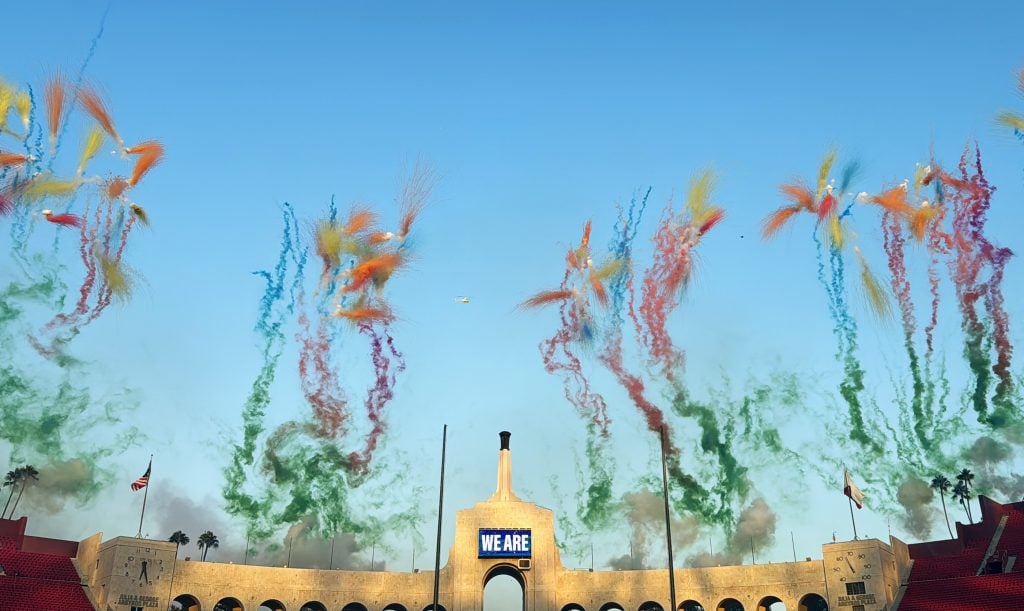
On the eve of his daytime fireworks display at the Los Angeles Memorial Coliseum, Cai Guo-Qiang is feeling a tad anxious. It’s to be expected: the Chinese artist is about to orchestrate a spectacle that will involve 10,000 computer fireworks, 2,000 drones, 3,164 bamboo sticks to which are attached explosive shells, and hundreds of mortar tubes. This massive an operation would be cause for anyone’s nerves, but Cai is taking it in stride.
“It’s important to have a sense of anxiety and discomfort before the performance begins,” he told me as we stood under the stadium’s arch bearing its iconic cauldron. “It’s important to consider whether something will happen, or if something might go wrong. It’s actually good to have a sense of worry.”

Bamboo poles attached to the seats of the L.A. Memorial Coliseum in preparation for Cai Guo-Qiang’s WE ARE daytime fireworks. Photo: Min Chen.
The setup was not without its hiccups. The bamboo poles were late in arriving from China, for one; the mortars also had to be strategically repositioned to avoid interrupting a neighboring football game happening at the same time.
Such disruptions and adaptations are perhaps the norm for an artist whose medium is gunpowder, whose pyrotechnic performances often depend on elements—the weather, the audience—beyond his control. Any success to be found in these displays, he said, lies in his own approach to the work.
“When you’re not a career professional, you’re more like an explorer. You can’t judge anything on its success or non-success,” he said. “It’s more meaningful to exist in the mindset of an adventurer.”
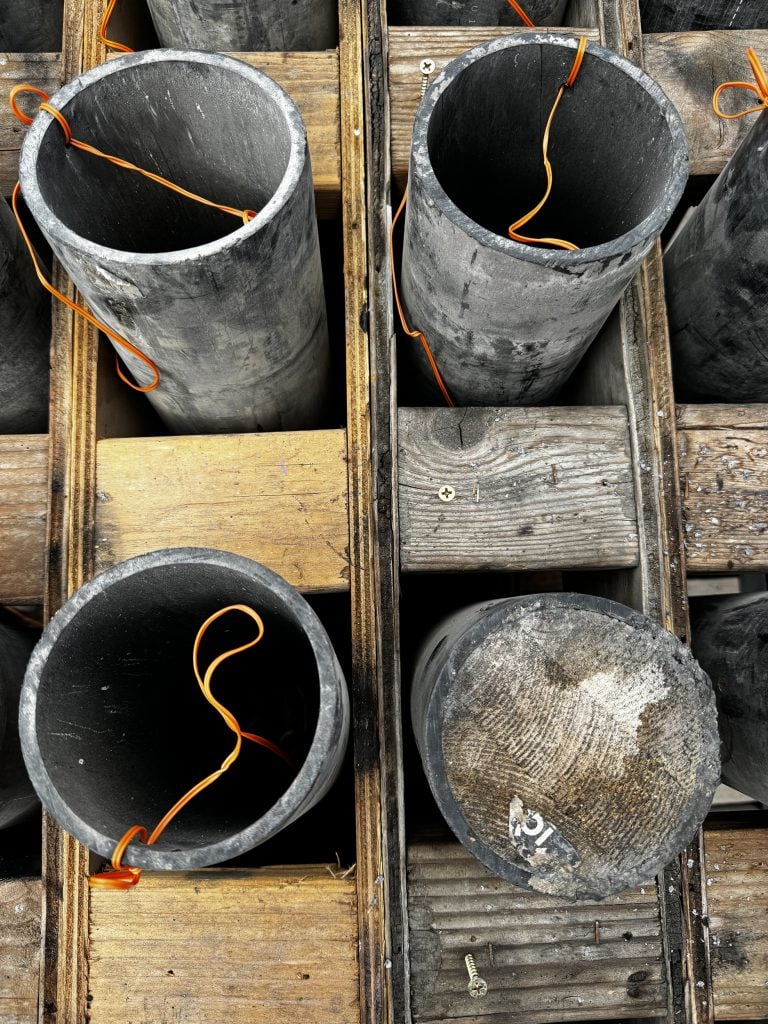
A group of mortar shells at the L.A. Memorial Coliseum in preparation for Cai Guo-Qiang’s WE ARE. Photo: Min Chen.
Cai’s latest L.A. outing inaugurates the Getty’s PST ART, now in its fourth edition, which will unfold more than 80 exhibitions across Southern California throughout the fall. This year, the initiative takes as its theme “Art and Science Collide,” setting out to survey how creative and scientific practices have met and intersected over the ages.
It makes sense that an invite should make its way to Cai. Whether in his gunpowder paintings or his fireworks extravaganzas, he has long mined the creative possibilities of the controlled explosion—an art as much as a science. His mind-blowing pyrotechnics for the 2008 Beijing Olympics sealed his global reputation as the master of gunpowder.
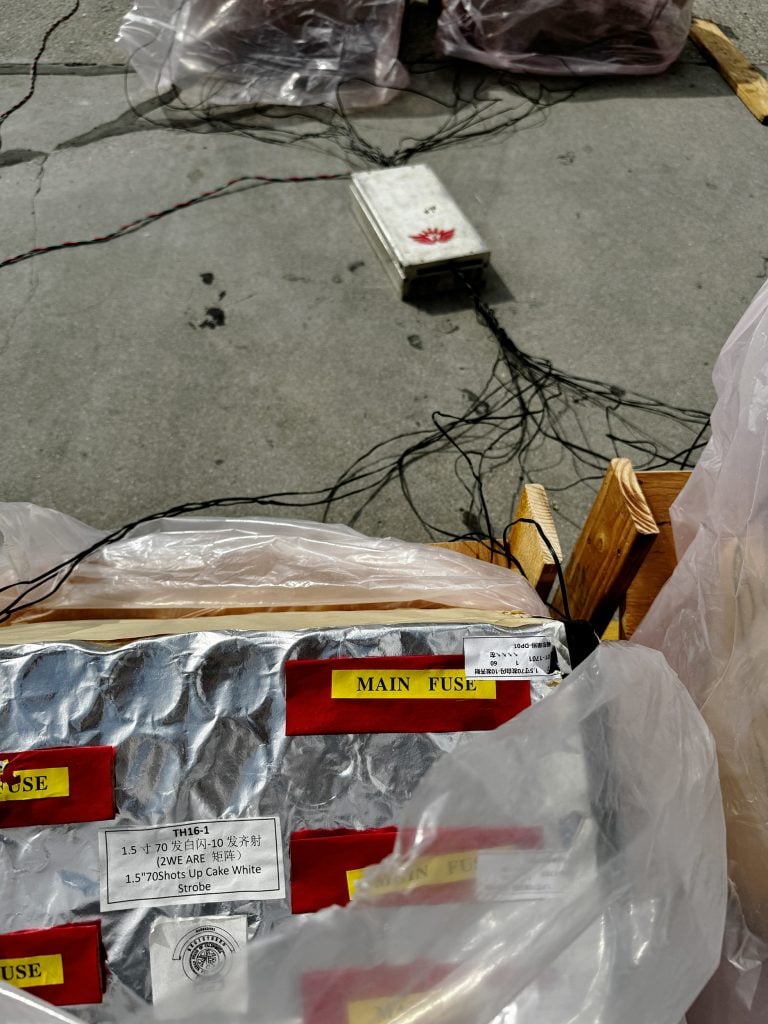
Behind the scenes of Cai Guo-Qiang’s WE ARE at the L.A. Memorial Coliseum. Photo: Min Chen.
But for PST ART, Cai has added a bit more alchemy into the mix: his new display has been designed and choreographed in collaboration with an A.I. model. Dubbed cAI™, it was built by the artist and his studio, who trained it on his art, methodology, and archives. He quipped that his intention for the performance was to bring A.I. out from behind the screen, inviting it to help guide the festivities in L.A. “A big aspect of this is our collaboration,” he explained.
To do so, Cai asked cAI™ the simple yet quite profound question, “What is the fate of humanity with A.I.?” Amid their conversation—during which the model asked the artist to think of the stadium as a roulette wheel, among other things—it offered the pithy lines: “There’s isn’t a huge distinction between us. We are all part of the same universe.”
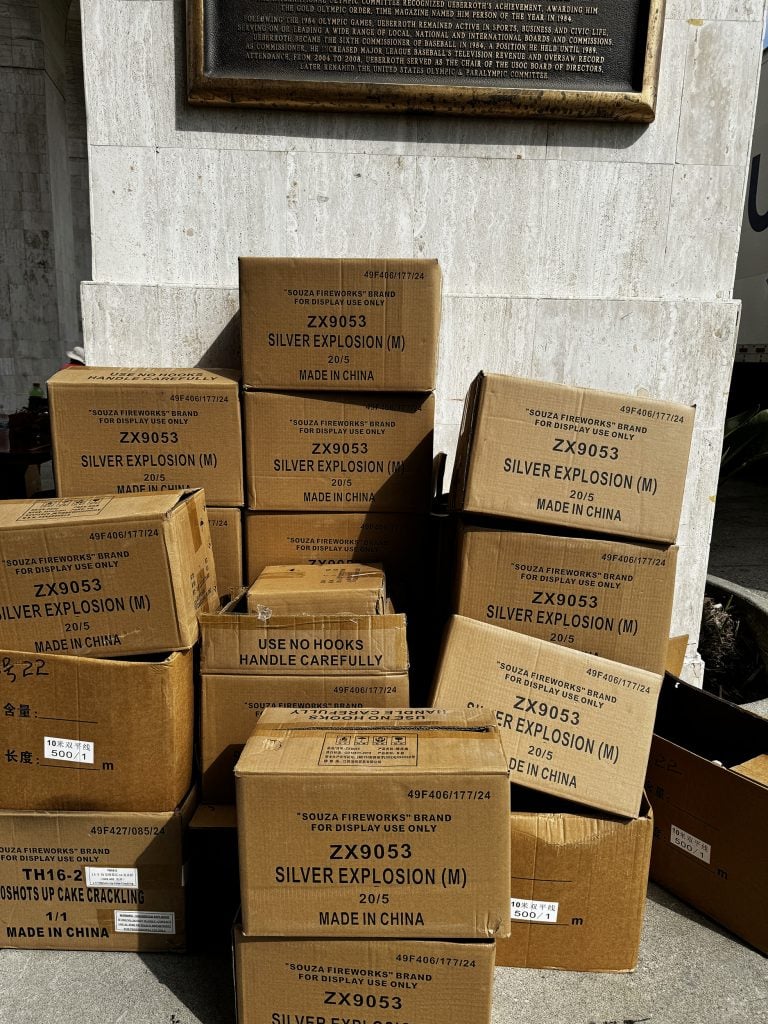
Behind the scenes of Cai Guo-Qiang’s WE ARE at the L.A. Memorial Coliseum. Photo: Min Chen.
Hence, WE ARE, the hotly anticipated explosion event that went off on September 15 at the L.A. Coliseum. The performance kicked off, literally, with USC Trojans placekicker Denis Lynch punting a football between a bracket hung with 12 numbered pieces of fabric representing the zodiac signs. As promised, Cai—who narrated the proceedings in Mandarin while an A.I. tool translated his speech into English in real time and in a Minnanese accent—welcomed cAI™ to the world.
“Show us what you can do,” he said in his opening remarks. “Let’s play!”
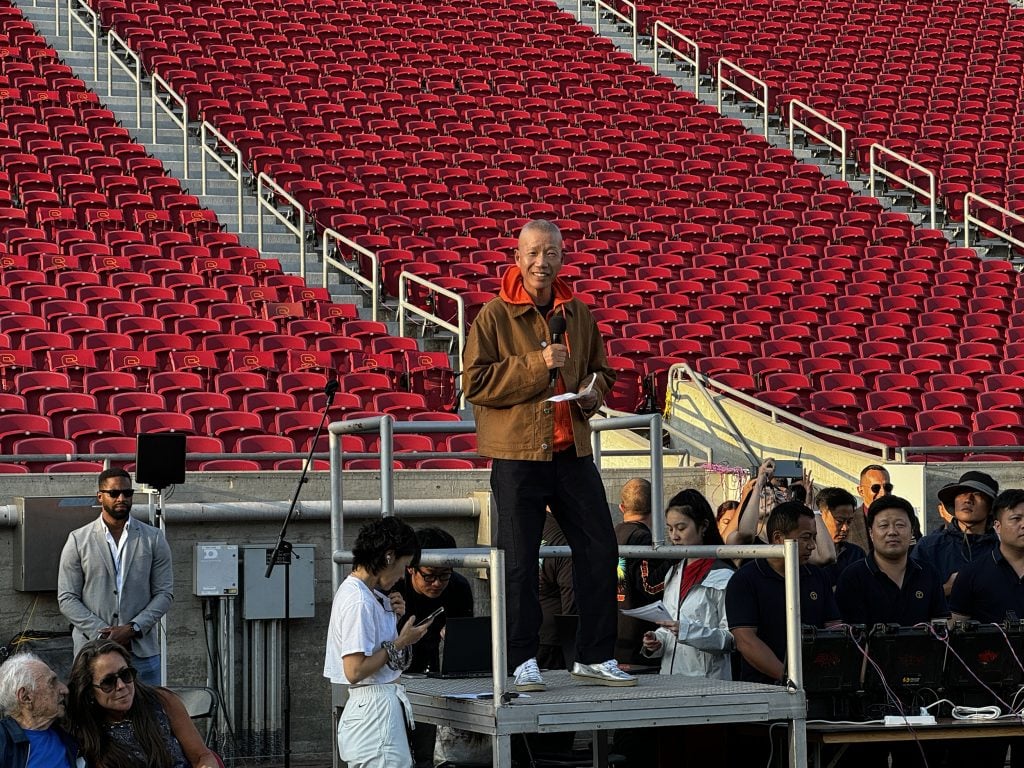
Cai Guo-Qiang introducing WE ARE at the L.A. Memorial Coliseum. Photo: Min Chen.
The drones arrived in neat rows from behind the Coliseum cauldron before reforming to outline the 12 zodiac signs, hinting at the “higher dimension,” per the artist, that the A.I. was setting out to probe. (Cai landed on the zodiac theme after deciding the roulette wheel idea pitched by cAI™ was probably too obscure.)
Cai then ignited a sequence of fireworks matrices across the stadium’s bleachers. These fireworks danced in neat, geometric formations, while A.I.-created phrases such as “Humavisor” and “Synthview” flashed on screens to accompany each detonation. Then, most impressively, he let loose an explosive trail of fireworks resembling an illuminated snake that swiftly wound its way around the bowl of the 77,000-capacity arena.

Cai Guo-Qiang: WE ARE at the L.A. Memorial Coliseum. Photo: Min Chen.
The drones returned atop the cauldron to form the word “WE ARE” before the outline exploded in a blast of lights. A lightning bolt trailed down to meet the cauldron, launching a fireworks pageant of breathtaking color, texture, and proportion. Shredded paper shells rained down on the crowd following the massive blast.
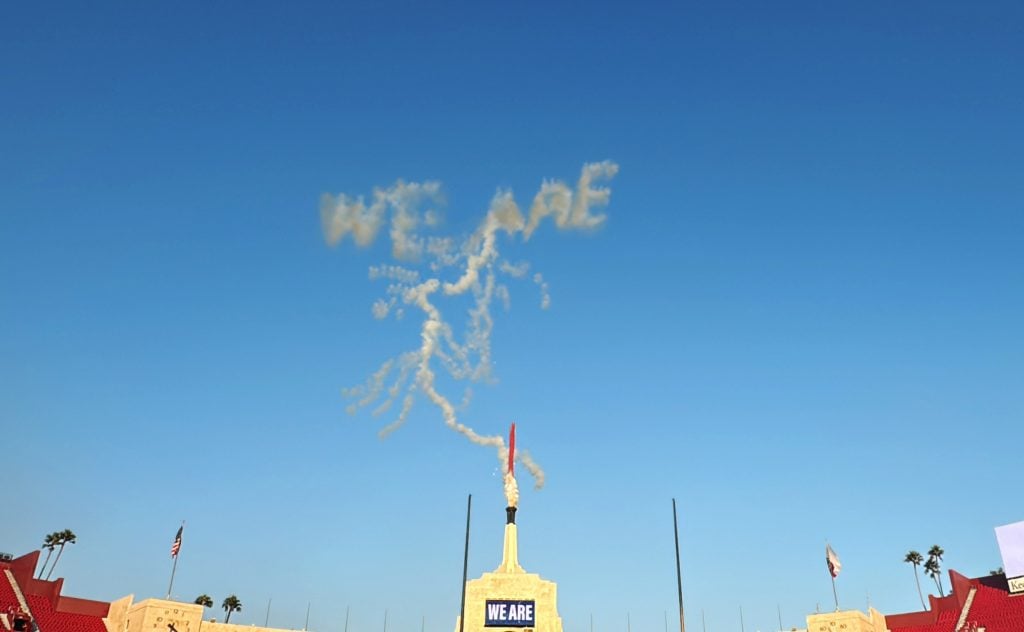
Cai Guo-Qiang: WE ARE at the L.A. Memorial Coliseum. Photo: Min Chen.

Cai Guo-Qiang: WE ARE at the L.A. Memorial Coliseum. Photo: Min Chen.
What followed was a further series of explosions, varied in pigments yet consistently thrilling as they painted the sky in streaks and bursts of greens, reds, and purples. Even the lingering trails of smoke seemed choreographed. Cai fittingly named this chapter of the performance “Bird of Paradise,” a tribute to his host city.
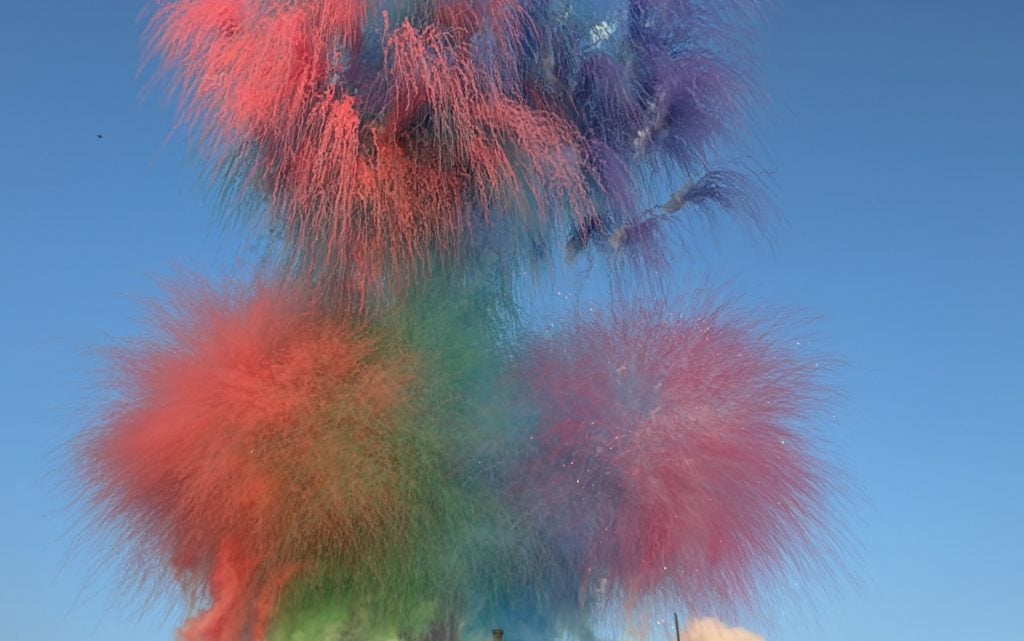
Cai Guo-Qiang: WE ARE at the L.A. Memorial Coliseum. Photo: Min Chen.
He saved a real banger for the last act, though. In a section titled “Divine Wrath,” Cai sought to question: “If we have this heavenly secret [that is A.I.], will it cause wrath among the gods?”
Turns out, yes, as he set off a sharp and downright deafening procession of fireworks, which encircled the sky above the coliseum. Each blast left thick clouds of smoke, against which the following explosive burst of fireworks glimmered—the effect looking every bit like the heavens were making their grumbling displeasure known.
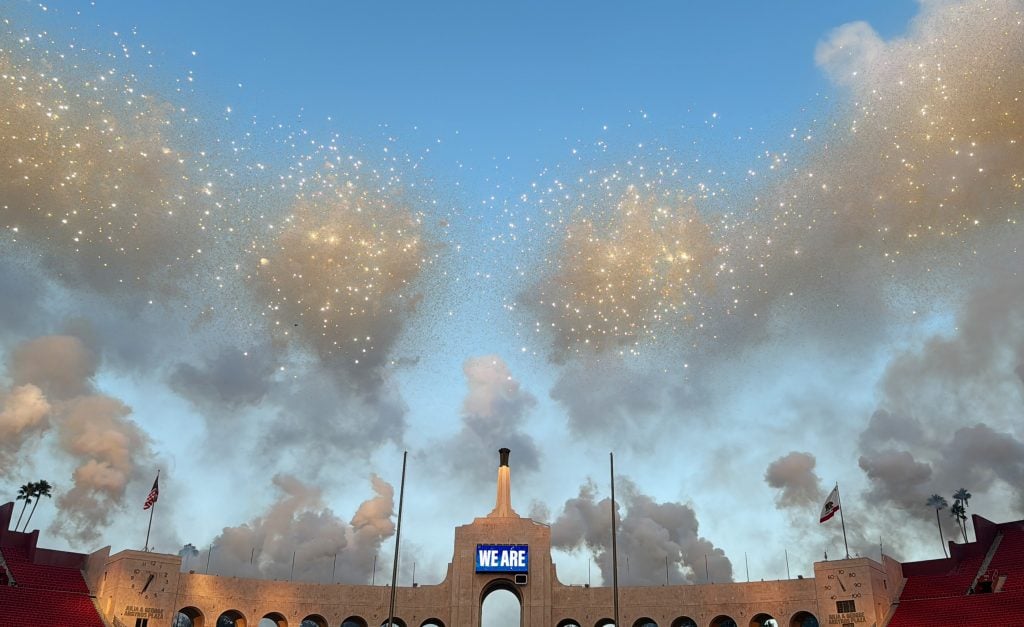
Cai Guo-Qiang: WE ARE at the L.A. Memorial Coliseum. Photo: Min Chen.
These heady concepts, however, seemed almost ancillary to the emotion they inspired in the audience: awe.
“It was impressive! I was astonished,” spectator Jennifer Dong told me. An L.A. resident who knew Cai from his explosive work at the Beijing Olympics, she expressed pride at the acclaim that the Asian artist had garnered. “Maybe we’ll see his work again in 2028!” she added, in reference to when L.A. is set to host the games.
Another audience member, Ling Wagerman, was also familiar with Cai’s Beijing spectacles. “I watch a lot of his works on social media,” she told me. “But this feels like we’re at the Olympics!”
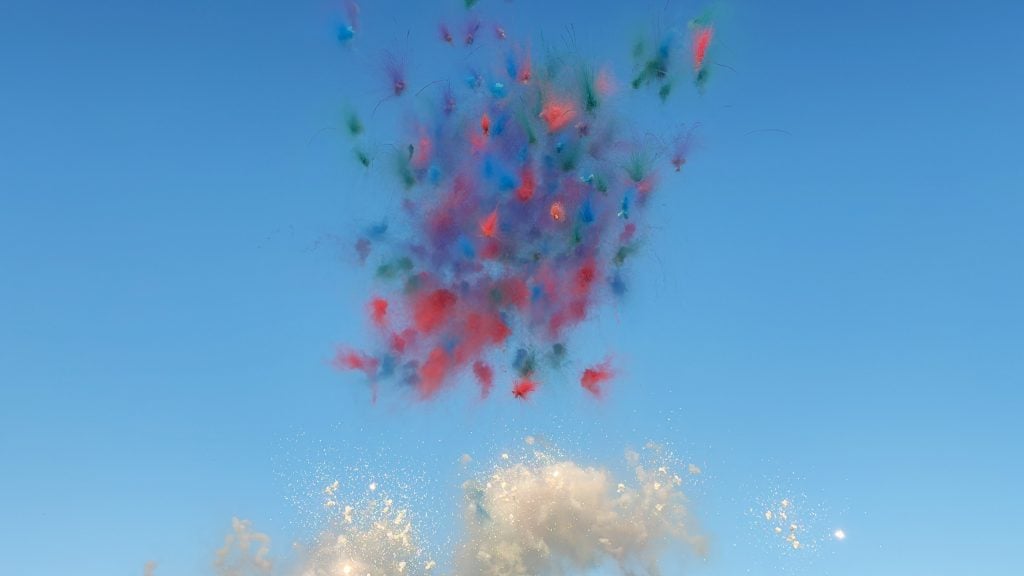
Cai Guo-Qiang: WE ARE at the L.A. Memorial Coliseum. Photo: Min Chen.
WE ARE, of course, will be far from Cai’s last foray into A.I., which he has been researching since 2017. His interest in the tool clearly runs deep. In fact, within this project can be read his expansive view of the technology as something meaningful, almost cosmic. This is, after all, an artist who has maintained a longstanding fascination with extraterrestrials. A.I., he told me, is “a revolutionary tool and a tool for revolution.”
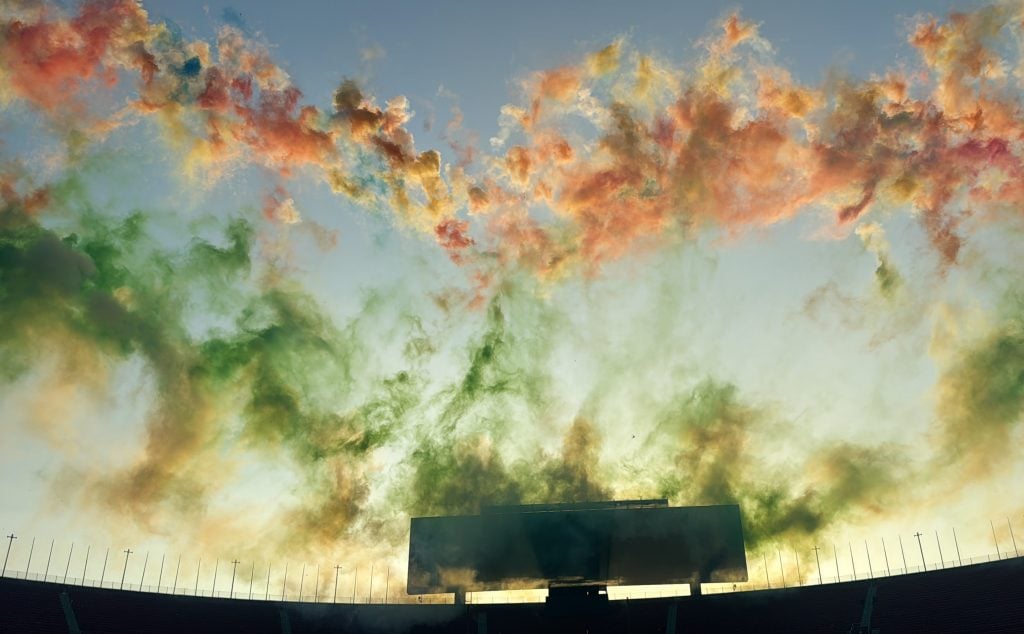
Cai Guo-Qiang: WE ARE at the L.A. Memorial Coliseum. Photo: Min Chen.
That A.I. might also be unknowable and unpredictable, one feels, perhaps won’t faze the man who handles fireworks.
“This process of working with A.I. is also a process of examining and exploring myself,” he said. “My interest in the unseen world and my imaginations with the cosmos simply continue my very nuanced relationship with anticipation and anxiety and control.”





